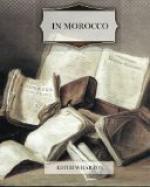[Illustration: From a photograph from the Service des Beaux-Arts au Maroc
Fez—the bazaars. A view of the Souk el Attarine and the Quaisarya (silk market)]
But when no exceptional events, processions, ceremonies and the like brighten the underworld of the souks, their look is uniformly melancholy. The gay bazaars, the gaily-painted houses, the flowers and flute-playing of North Africa, are found in her Mediterranean ports, in contact with European influences. The farther west she extends, the more she becomes self-contained, sombre, uninfluenced, a gloomy fanatic with her back to the walls of the Atlantic and the Atlas. Color and laughter lie mostly along the trade-routes, where the peoples of the world come and go in curiosity and rivalry. This ashen crowd swarming gloomily through the dark tunnels represents the real Moghreb that is close to the wild tribes of the “hinterland” and the grim feudal fortresses of the Atlas. How close, one has only to go out to Sefrou on a market-day to see.
Sefrou is a military outpost in an oasis under the Atlas, about forty miles south of Fez. To most people the word “oasis” evokes palms and sand; but though Morocco possesses many oases it has no pure sand and few palms. I remember it as a considerable event when I discovered one from my lofty window at Bou-Jeloud.
The bled is made of very different stuff from the sand-ocean of the Sahara. The light plays few tricks with it. Its monotony is wearisome rather than impressive, and the fact that it is seldom without some form of dwarfish vegetation makes the transition less startling when the alluvial green is finally reached. One had always half expected it, and it does not spring at a djinn’s wave out of sterile gold.
But the fact brings its own compensations. Moroccan oases differ one from another far more than those of South Algeria and Tunisia. Some have no palms, others but a few, others are real palm-oases, though even in the south (at least on the hither side of the great Atlas) none spreads out a dense uniform roofing of metal-blue fronds like the date-oases of Biskra or Tozeur. As for Sefrou, which Foucauld called the most beautiful oasis of Morocco, it is simply an extremely fertile valley with vineyards and orchards stretching up to a fine background of mountains. But the fact that it lies just below the Atlas makes it an important market-place and centre of caravans.
Though so near Fez it is still almost on the disputed border between the loyal and the “unsubmissive” tribes, those that are Blad-Makhzen (of the Sultan’s government) and those that are against it. Until recently, therefore, it has been inaccessible to visitors, and even now a strongly fortified French post dominates the height above the town. Looking down from the fort, one distinguishes, through masses of many-tinted green, a suburb of Arab houses in gardens, and below, on the river, Sefrou itself, a stout little walled town with angle-towers defiantly thrust forth toward the Atlas. It is just outside these walls that the market is held.




